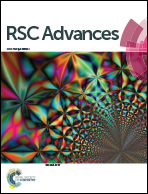An ab initio study of TiS3: a promising electrode material for rechargeable Li and Na ion batteries†
Abstract
Titanium trisulfide (TiS3) was recently reported to be highly promising as an electrode material for Li-ion batteries, due to its multielectron processes with high theoretical capacity. However, theoretical work on the performance and mechanism of Li adsorption in bulk and monolayer TiS3 is still lacking. The constraint of lithium resource also requires replacement by an abundant material such as Na. Using first principles calculations based on density functional theory, this study extensively investigates the electronic structure, adsorption and diffusion properties, capacity and plateaus of Li and Na atoms in bulk and monolayer TiS3. The results reveal that as the thickness of the TiS3 material decreased to a monolayer, a transition from an indirect band gap to a direct band gap was induced. Both the difference in charge density and the Bader charge analysis show that a significant charge transfer occurs from a Li or Na adatom to its neighboring sulfur atoms. Additionally, in bulk and monolayer TiS3, both Li and Na show two diffusion pathways with a low diffusion barrier, and one pathway can be further enhanced as the TiS3 changes from bulk to monolayer. Moreover, monolayer TiS3 shows a lower energy barrier for Na atoms, and there is also no problem associated with volume expansion in bulk TiS3. At high Li/Na concentrations, the Li/Na atoms can also diffuse easily, and one diffusion pathway is viable in bulk TiS3, which is effective for direct diffusion. All these properties are promising for the development of Li and Na batteries based on bulk and monolayer TiS3.


 Please wait while we load your content...
Please wait while we load your content...